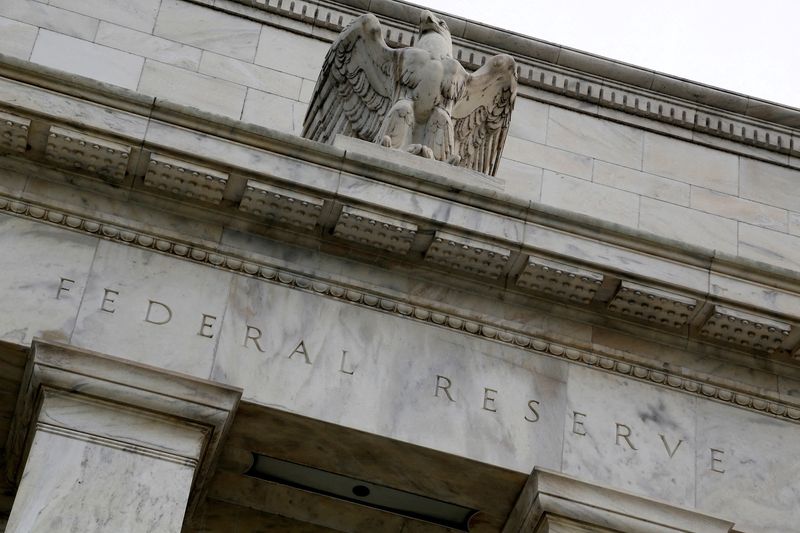By Michael S. Derby
NEW YORK (Reuters) - The bond market tumult that has sent real-world borrowing costs surging is unlikely to deter the Federal Reserve from pressing onward with shedding nearly $100 billion of bonds each month from its $8 trillion balance sheet, analysts say.
That’s because even as yields have surged and sparked new fears over a potential recession, the move has been relatively orderly even if it's been outsized. Key measures of bond market volatility and liquidity are not flashing the warning signs they did just this past spring when Silicon Valley Bank failed and forced the Fed to launch a new emergency bank lending facility.
What’s more, pricier credit is in line with central bank officials’ desire to have interest rates at levels restrictive enough to slow growth and lower inflation back to their 2% target.
“I do not think the Fed would stop QT (quantitative tightening) unless there is a structural, liquidity issue in the Treasury market,” said Kathy Bostjancic, chief economist with insurance firm Nationwide.
Since June 2022, the Fed has allowed more than $1 trillion of bonds to mature from its portfolio, including roughly $840 billion of Treasuries. Alongside the 5.25 percentage points of Fed interest rate hikes delivered since March 2022, QT is meant to withdraw stimulus from the economy, although officials stress that rates are their primary tool.
The QT process “is just playing a minor role in the rise” in market rates, Bostjancic said, and those gains are “really due to the markets embracing the Fed’s higher-for-longer guidance” on rates.
The stopping-QT-soon argument rests on a view that bond yields have gone up too much and liquidity is too poor, so ending portfolio run-off could relieve upward pressure on rates.
And the market pressure is real: In the two weeks since the Fed's last meeting, the 10-year note yield shot up by more than 50 basis points to nearly 4.9%, including a 15 basis point leg higher on Friday after nonfarm payrolls growth for September came in at close to double what was expected. A closely watched index from Goldman Sachs showed U.S. financial conditions near their tightest for the year on Wednesday.
A FRESH HEADWIND
So far, Fed officials themselves are unperturbed.
Cleveland Fed President Loretta Mester said Tuesday “over the next year, those tighter or higher rates will have an impact on the economy and we just have to take that into account when we're setting monetary policy."
Meanwhile, in a Bloomberg podcast out Thursday Chicago Fed President Austan Goolsbee said the market move "is not a puzzle... it's clear that the long rates coming up is what you'd expect."
To another, it may dent the case for more rate hikes.
San Francisco Fed President Mary Daly on Thursday said with the rise in market rates, “the need for us to take further action is diminished because financial markets are already moving into that direction and they've done the work."
While not seeing current events bringing an end to QT, some analysts see a growing case for it wrapping up next year.
QT drains liquidity from the banking system, reducing bank reserves parked at the Fed and cash stashed in its reverse repo facility. The Fed wants reserves sufficient to allow firm control over its benchmark federal funds rate, but no more, and finding that sweet spot is hard.
Michael Barr, the Fed's top bank overseer, said on Monday the Fed is "attentive" to the reserves issue and noted "that's something that we are going to feel our way towards - we are not anywhere close to it now, today."
HOW MUCH LONGER?
The Fed's first stab at QT ended abruptly in September 2019, when it went too far and lost control of the target rate. Some worry that could happen again.
“We didn't get a lot of warning last time,” UBS strategist Michael Cloherty said Thursday at an event held by the Bank Policy Institute, a Washington lobbying group. When reserve scarcity hits this time, “I think we're just going to slam into” it with little warning.
Others believe money market rates will start to move up in ways suggesting the system is short of cash. A canary in the coal mine might be the Fed’s Standing Repo Facility, a largely untested safety valve for market stress that could see a sudden surge in demand.
There’s no firm sense of a timeline on when QT might finish.
A New York Fed report in April projected an end to QT around the middle of 2025. A survey of major banks by the New York Fed released in August eyed an end to QT in mid-2024.
Mark Cabana, rates strategist with Bank of America, said QT likely has around a year to go and that reserves are already more scarce than many recognize because banks are already hoarding cash.
“We would argue that banks are already liquidity scarce, and if that's right, then how long can QT really last? It can only really last until the overnight RP is substantially depleted,” Cabana said.
Daily overnight reverse repo balances have tumbled by more than $1 trillion since early April to just over $1.6 trillion as of Wednesday, Fed data shows. At the current rate, Cabana said that end point is likely in about 13 months.
